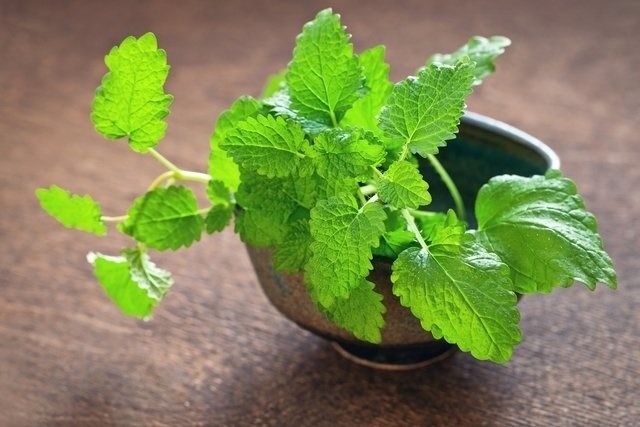Lemon Balm is a perennial herb native to the Mediterranean, but now grows rapidly throughout the world. It’s a member of the mint family and because all mints have square stems, identifying this herb is as easy as crushing a leaf between your fingers. If the aroma released is sweet, lemony, and slightly minty, you can bet it’s lemon balm. Why should you grow lemon balm in your garden? Here are 7 reasons!

Heals minor wounds and skin disorders.
To stop bacterial infections, heal minor cuts, acne, and eczema, make a strong topical lemon balm tea. Directions: Place about 1/2 cup of freshly chopped lemon balm leaves into a glass jar. Cover with 1 cup of boiling water. Cover and allow steeping. Once the mixture has cooled, strain out the leaves. Saturate a cotton pad with the tea and dab onto the skin to promote healing. If you don’t have a plant on hand, apply a drop of lemon balm essential oil or extract mixed with almond oil directly on the affected area of the skin.
Relieves pain and swelling of insect bites.
When you get an insect bite or bee sting, reach for a lemon balm plant. To release the plant’s beneficial oil, crush or chew a leaf or two, and apply directly to the affected area to relieve pain and reduce swelling. No plant on hand? Apply a drop of lemon balm extract or essential oil mixed with almond oil directly on the bee sting.
Treats cold sores.
This herb helps reduce swelling, relieve discomfort and heal a cold sore. Dilute a drop or two of lemon balm essential oil (or extract) in ¼ teaspoon of jojoba or almond oil, and apply directly on affected area. Or make a strong topical tea, following the instructions in #2. Once cooled, strain out the leaves. Apply a cotton pad soaked with the tea to the affected area.
Soothes sore muscles.
Soothe tired muscles, calm nerves, and nourish the skin with the fragrant aroma of lemon balm in an Epsom salt bath. Directions: To a sachet bag or muslin cloth add 1 cup of Epsom salt, ½ cup baking soda, and ½ cup lemon balm leaves. Gather the cloth and secure with a long string. Hang from the tub faucet, allowing the hot water to run through the bag while filling the tub. Then untie the bag and let it drop into the water. Enjoy soaking in the calming, mood-lifting bath for up to 30 minutes.
Good in bath & body products.
The leaves of this beneficial herb are loaded with potent antioxidants that you can take advantage of in the form a hair rinse.
Fill a jar ¾ full with lemon balm leaves and cover them with apple cider vinegar, letting it sit for few days before using as desired to keep your hair silky soft!
As you try to unwind, try a lemon balm bath soak. Use lemon balm instead of mint. It will soothe your skin while also relaxing it!
Tastes great in drinks.
In the 14th century, Carmelite nuns developed a cordial made from infusing lemon balm leaves, alcohol, lemon peel and other ingredients. The popular drink was used to reduce headaches as well as people used it as perfume!
Chartreuse and Benedictine are still around today, and they are still said to have healing ingredients! Why? Because lemon balm is the main ingredient.
Another way to use lemon balm leaves is by infusing them in honey and adding a dollop into your healing teas as you end each day.
Repel mosquitoes without harmful chemicals.
This herb is also a natural bug repellent and makes a great DEET-free alternative to those typical chemical-filled, toxic sprays.
Researchers have found that repellents that contain DEET may disrupt the hormone dopamine which is important for healthy brain functioning, interfere with proper nerve signals and trigger chemical mechanisms that are linked to nerve degeneration and neurological disorders.
Leave a reply













